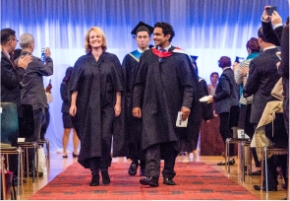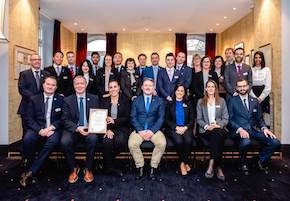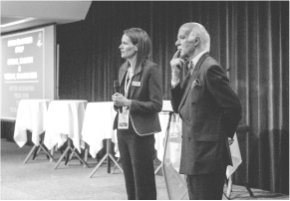- About
- Programs
- Innovation & Research
- Campus Life
- Career Services
- Admissions
- News & Events
- Alumni
Women in C-Suite Leadership: Shaping the Future of Business
Explore the impact of women in C Suite leadership, meet 10 trailblazers, and learn how to break barriers in executive roles. Read the full guide now.
Key Takeaways
- Women in C-Suite roles consistently strengthen financial performance and employee engagement.
- Systemic barriers, including bias, lack of mentorship, and cultural attitudes, continue to limit women's advancement.
- Successful female executives serve as role models while implementing strategies that benefit entire organizations.
- Organizations can accelerate progress through transparent processes, mentorship programs, and leadership accountability.
Women now make up nearly half of the global workforce, according to the World Economic Forum's Global Gender Gap Report. Yet representation at the top tells a different story—McKinsey's Women in the Workplace study shows that only 29% of C-suite positions in large organizations are held by women.
This gap is still far from where it should be, but progress is undeniable. More women are breaking through the glass ceiling than ever before, and each year the share of women in C-suite leadership continues to grow. These advancements are, in part, the result of the women who came before—those who challenged barriers and opened doors for the next generation to step through.
The Impact of Women in C-Suite Leadership
Your Leadership Journey Starts Here
Master the art of hospitality management
Reducing the underrepresentation of women in senior leadership is not only a matter of fairness but also a proven business advantage. Companies with more women in executive roles tend to achieve stronger financial performance and create workplace environments where employees are more engaged.
Over the past decade, women-led Fortune 500 companies delivered a 223% return on equity (ROE), compared to 130% for male-led firms. That's a 93-point difference, showing that organizations with women at the top generate greater value from their investors' capital.
Boards with at least 20% female representation also see a 25% higher ROE and a 1.4% higher return on assets (ROA), meaning they use shareholder money more effectively and also make better use of company resources. These results suggest that women in C-suite leadership contribute to smarter risk management, stronger oversight, and more sustainable growth strategies.
The impact of women in C-suite leadership extends to people as well as profits. Gallup research shows female managers are more likely to be engaged in their roles than male managers (41% vs. 35%), and this engagement has a ripple effect across teams. Employees working for female managers are six percentage points more engaged on average, with female employees under female leaders reporting the highest engagement (35%).
Engagement matters because it drives productivity, lowers turnover, and builds loyalty. In fact, employees of female managers outscore those of male managers on 11 of Gallup's 12 engagement measures, reflecting more supportive and connected workplace environments.
These are only some of the ways women in C-suite leadership make a difference. Their leadership often emphasizes collaboration, emotional intelligence, inclusivity, and long-term thinking. Together, these leadership qualities strengthen decision-making, support innovation, improve stability, and help organizations remain competitive in changing markets.
10 Influential Women in C-Suite Leadership
The broader societal impact of women in C-suite leadership is just as important as the influence they have within their organizations. Their presence at the highest levels challenges old assumptions and signals to younger generations that leadership excellence is not bound by gender.
The following leaders are examples of changemakers who have helped pave the way and made it easier for future generations to envision themselves in top leadership roles.
1. Jane Fraser
In 2021, Jane Fraser became the first woman to lead Citigroup, one of the four biggest investment banks in the United States and a key player in global finance. Her appointment was historic because banking has long been an industry where women rarely reach the highest levels of leadership.
Since reaching the top, Fraser has worked to simplify a notoriously complex institution and rebuild trust through stronger risk management. She has also made diversity and workplace flexibility a priority, recognizing that global banks must adapt to regulatory and market pressures as well as the expectations of their workforce.
2. Mary Barra
For decades, the auto industry has also been stereotyped as a man's world, with leadership dominated by male executives. Mary Barra disrupted that image when she became CEO of General Motors in 2014, the first woman to lead a major global automaker. She took charge during a period of safety crises and uncertainty, with the company under pressure to rebuild trust and adapt to a changing market.
Since then, Barra has set GM on a bold new course. She committed the automaker to phasing out gas-powered vehicles by 2035, making electric mobility the centerpiece of its future. Inside the company, she has emphasized accountability and openness, pushing cultural reforms that replaced hierarchy with transparency and responsibility.
3. Julie Sweet
Julie Sweet leads Accenture, one of the world's largest consulting firms, with more than 700,000 employees and clients in over 120 countries. As CEO since 2019, she has overseen a company whose influence extends far beyond its own walls, shaping the strategies and technology choices of businesses across nearly every sector.
Since becoming CEO in 2019, she has led Accenture's global consulting work with clients across sectors, focusing on helping companies adapt to disruptive shifts in technology, markets, and workforce expectations. She has also expanded the firm's sustainability consulting, positioning Accenture as a partner for organizations under growing pressure to balance growth with responsibility.
4. Safra Catz
Oracle is one of the pillars of enterprise technology, with software and databases that keep the world's largest companies running. Safra Catz, who has led the firm since 2014, has been central to keeping it competitive during a period of massive upheaval in the tech sector.
Catz is known for her disciplined, numbers-driven approach. She has played a key role in Oracle's bold acquisition strategy, overseeing deals that transformed the company's presence in both software and hardware. More recently, she has guided Oracle's pivot to cloud computing.
5. Lisa Su
When Lisa Su took over Advanced Micro Devices (AMD) in 2014, the company was on the verge of collapse. Years of missteps had left it struggling to compete with other companies, and many doubted whether it could survive.
Su, an engineer by training, focused the company on what it could do best: designing powerful processors that rivaled the industry leaders. Within a few years, AMD's Ryzen and EPYC chips had revived the company's reputation and made it a serious competitor again in both consumer and enterprise markets.
Her turnaround of AMD is now seen as one of the most remarkable in the technology sector.
6. Thasunda Brown Duckett
Thasunda Brown Duckett is one of the few Black women to lead a Fortune 500 company, becoming CEO of TIAA in 2021. At TIAA, which manages retirement and investment assets for millions of Americans, she has carried forward her long-standing mission of expanding financial inclusion and closing wealth gaps, making equity central to the firm's role in retirement security.
She has used her platform to push for broader access to retirement planning, support programs that address systemic inequities, and show how a financial services company can be both profitable and committed to social impact.
7. Sarah London
Healthcare leadership carries stakes few industries can match. Sarah London became CEO of Centene Corporation in 2022, guiding a company that provides coverage to more than 28 million Americans, many of them Medicaid recipients. Decisions made at Centene directly influence how vulnerable populations access care.
London stepped into the role at a time of rapid growth and heightened regulatory scrutiny. She has worked to strengthen compliance, improve efficiency, and invest in data-driven models of care. She has also advanced the use of technology to expand access and deliver better patient outcomes.
8. Carol Tomé
UPS was under extraordinary pressure in 2020 as global supply chains strained and delivery demand surged. Carol Tomé, the first woman to lead the company in its century-long history, responded by redefining its priorities.
Her "better, not bigger" strategy shifted focus away from sheer volume and toward profitability, efficiency, and sustainability. That reset helped UPS stay stable in a period of crisis while positioning it for long-term resilience.
9. Phebe Novakovic
Phebe Novakovic's path to corporate leadership is anything but typical. Before entering business, she built her career at the CIA, an experience that sharpened the skills she now uses to run one of the most complex defense companies in the world. Since 2013, she has led General Dynamics, whose work ranges from Gulfstream private jets to nuclear submarines for the U.S. Navy.
Her tenure has required balancing the politics of government contracts, the demands of military technology, and the expectations of shareholders—challenges few industries compress into a single role. She has guided the company through shifting defense priorities while pushing for steady innovation, keeping General Dynamics competitive in one of the most scrutinized and high-stakes sectors of the global economy.
10. Barbara Rentler
Barbara Rentler built her career at Ross Stores step by step, rising through the company over decades before becoming CEO in 2014. Unlike many high-profile retail leaders, she has kept a low public profile, choosing to let performance speak for itself. Today, she oversees one of the largest off-price chains in the United States, with more than 1,700 locations.
Her tenure has spanned one of the toughest periods in modern retail, marked by the rise of e-commerce and rapid shifts in consumer behavior. While competitors stumbled, Rentler kept Ross profitable by doubling down on operational discipline and staying closely attuned to budget-conscious shoppers.
Systemic Barriers Facing Women on the Path to the C-Suite
Although it's clear that women can and do reach the highest levels of leadership, their way up is still shaped by systemic barriers that make progress more difficult than it should be. These obstacles are embedded in workplace culture and evaluation systems.
Bias and stereotypes remain constant hurdles. Women are frequently assessed through a different lens than men: traits like decisiveness or assertiveness, praised in male leaders, are labeled "aggressive" when shown by women.
These perceptions are reinforced in the feedback women receive. In one study, 76% of high-performing women received negative personality-based comments in their reviews, compared with only 2% of men.
Often, women are judged on who they are, while men are judged on what they deliver. Over time, this erodes women's credibility, making it harder for them to be considered "ready" for promotion or trusted with stretch assignments.
By focusing attention on style rather than substance, these biases slow advancement and create an uneven playing field where even strong results are not enough for women to reach the same recognition as their male peers.
Limited mentorship and sponsorship add to the challenge. Advancement to senior levels rarely happens through skill alone; it also depends on senior leaders actively supporting someone for new roles and projects. Because most executives are still men, women have fewer natural connections to those advocates. Without strong sponsors, they risk being overlooked when opportunities for stretch assignments or board-level visibility arise.
Cultural expectations within organizations also often reinforce male-centered leadership models. Traits associated with traditional leadership, like competitiveness, toughness, or constant availability, are positioned as the standard. Women who lead differently, whether through empathy, collaboration, or adaptability, often find their style questioned, even when it delivers results. This pressure to "fit the mold" discourages authentic leadership and limits recognition for alternative but effective approaches.
These barriers compound when race, socioeconomic status, or industry dynamics are added. Women of color and those from underrepresented backgrounds face overlapping layers of exclusion that make advancement even harder. Addressing these inequities requires more than isolated initiatives; it demands systemic change that reshapes how leadership potential is recognized and developed.
Strategies to Increase Women in the C-Suite
For more women to advance into senior leadership, organizations need more than statements of support. They need systems that remove bias and open doors. Progress comes when both structural reforms and cultural shifts work together to create real opportunity.
Clear evaluation processes are one starting point. When promotion criteria are transparent and consistently applied, stereotypes play a smaller role in advancement. Bias training for managers and executives can also help challenge unconscious assumptions that often influence who is viewed as "leadership material."
Mentorship and sponsorship remain among the most crucial levers for change. Women who have senior leaders advocating for them gain visibility for high-profile assignments and advancement opportunities.
At César Ritz Colleges Switzerland (CRCS), this principle is built into student life. Through Career Services and the International Recruitment Forum, students meet industry leaders and recruiters who provide guidance and access to networks. As student Dasha Butler explained, "The most valuable aspect of the IRF experience for me is the networking opportunities it provides… Establishing connections early on can prove beneficial in the long run, as you never know who your future employer might be or what connections you'll need down the line." Her words capture exactly why structured sponsorship matters: it turns potential into opportunity.
Accountability is equally essential. When organizations set representation targets and track results, progress becomes measurable rather than rhetorical. And when executives themselves are evaluated on diversity outcomes, equity moves from being a side initiative to an expectation of leadership.
Paving the Way for the Next Generation of Female Leaders
Leaders like Jane Fraser and Lisa Su stand out not because they are women who "managed to make it," but because they are remarkable leaders by any measure. Accomplishments like these prove leadership has nothing to do with gender. Yet, obstacles remain that continue to limit how often such talent is acknowledged.
At CRCS, the challenges that often hold talented people back, such as limited access to mentors or restricted professional networks, are addressed through dedicated support and international exposure. Students gain academic expertise alongside industry connections and tailored guidance, all within a learning environment that prioritizes equity and opportunity.
This focus extends into all our programs, including the Master of Science in Leadership, where students build the skills needed to step confidently into senior positions, including future C-Suite roles. The program develops strategic thinking, strengthens decision-making under pressure, and prepares graduates to guide organizations through change.
We believe in giving every student the support to learn to lead and lead to succeed.
Frequently Asked Questions
What leadership style do women use?
Women often employ transformational and collaborative leadership styles, emphasizing emotional intelligence, team building, and inclusive decision-making processes.
What industries have the highest number of women in executive roles?
Industries with the highest share of women in executive roles include education administration, individual and family services, civic and social organizations, wellness and fitness, and healthcare. By contrast, sectors like technology and finance still show lower representation.
How can companies support more women into C-Suite positions?
Companies can implement mentorship programs, ensure transparent promotion processes, create positive company culture, and establish accountability measures for leadership diversity goals.
Do you dream of a career in the hospitality business? Start your application and take that first step.




















